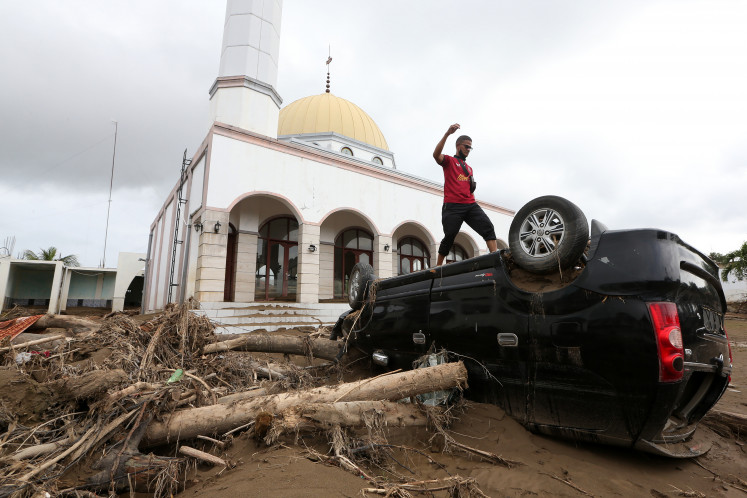Popular Reads
Top Results
Can't find what you're looking for?
View all search resultsPopular Reads
Top Results
Can't find what you're looking for?
View all search resultsThe endless cycle of forest fires
Forest fires and haze have become an annual problem for Indonesia
Change text size
Gift Premium Articles
to Anyone
F
orest fires and haze have become an annual problem for Indonesia. During the dry season, forest fires always occur, especially in Sumatra and Kalimantan. Haze covers the sky; causes problems for the transportation sector; reduces economic activities; and stimulates health problems.
The problem has not only become a domestic affair but also affects Indonesia’s reputation in other countries. Singapore and Malaysia are two of the most adversely affected foreign countries due to the smog generated from the forest fires. This is called negative externalities by economists.
We might still remember how the Malaysian government sent hundreds of fire squads, called “Bomba”, to help Indonesia to fight forest fires in 1997. The forest fire tragedy that year was one of the worst forest fires in Indonesian history, in which the smog even reached Thailand and the Philippines.
The haze generated from this year’s forest fires is predicted to have negative effects on the SEA Games in South Sumatra, which will be held in November (The Jakarta Post, Sept. 10). This sporting event is not only under the spotlight due to corruption allegations in relation to the construction of the athletes’ complex, but is also dogged by environmental problems. This could produce negative images and a bad reputation for this country if the sports competition is disturbed by smog.
In the middle of the two-year forest-conversion moratorium program, forest fires are still a cause of deforestation. When it is burnt, vegetation, which in fact plays a role in balancing carbon in the atmosphere, contributes significantly to the amount of carbon released into the atmosphere. If the fires occur in peatlands, the quantity of carbon released is much higher than in other types of ecosystem.
Based on the pattern of forest fires in Indonesia, the intensity of fires is very much affected by the length of the dry season. When there is a long period of low rainfall, litter and vegetation become a perfect fuel for flames. The terrible 1997 forest fires, for example, occurred during a long dry season due to the El Niño cycle. With the possibility of prolonged dry seasons and climate change in the future, the threat of forest fires will also be more serious.
Fire is a friend and, at the same time, a foe for natural ecosystem-management. It can be utilized as a habitat-manipulation tool as well as a population-enhancement method. Controlled burning is applied to reduce the risk of uncontrolled fires in ecosystem management.
In Indonesia, fire is employed in land preparation, which serves as a cheap and fast method of land clearing. However, the use of fire for agriculture has been blamed for forest fires.
Traditionally, “slash and burn” agriculture has been practiced by farmers in many places in Indonesia for generations. A study conducted in West Kalimantan showed that the application of slash and burn agriculture, in combination with land rotation, is ecologically sustainable and does not degrade soil conditions (Kleinmann et al., 1996).
However, it requires that slash and burn techniques only involve a small number of farmers across relatively wide areas, so there is sufficient time for the ecosystem to recover. As agricultural practices tend to be more settled and agricultural areas are more limited, the application of slash and burn agriculture should be stopped because it is ecologically unfeasible.
The problem is that the use of fire as a land clearing method is also adopted by large plantation companies and forest-plantation management. The main reason is, of course, to reduce production costs.
Nonetheless, with large areas being burned every year and low soil, air and vegetation moisture during the dry season, the application of fire for land clearing is likely to end up in uncontrolled fires. Unsurprisingly, from the total land affected by fires this year, more than 70 percent occurred in plantation fields.
The question is, “what has to be done to reduce the risk of annual forest fires?” It is certainly not an easy task, but effective measures have to be taken. The use of fire for land clearing which involves large areas, especially during the dry season, must be prohibited.
Therefore, the establishment of more powerful legislation to serve as a legal foundation to tackle forest fires is needed. Existing legal instruments are not adequate to stop and punish companies or people who cause forest fires.
Government Decree No. 41/2001, regarding action to control environmental destruction due to forest fires, does not have the teeth to penalize offenders.
Furthermore, some aspects of this decree are linked to the 1997 Environmental Law, which has now been replaced by the new Environmental Law No. 32/2009.
The development of new technology provides more effective ways to anticipate and to reduce the risk of forest fires. Satellite imaging can quickly supply information on land and vegetation condition changes, which could provide real time information on forest-fire risk levels. It is more possible to detect the establishment of hot spots.
Aerial photography can even provide legal evidence if companies intentionally burn forests. Preemptive actions to avoid massive forest fires could decrease the possibility of loss due to this disaster.
We can’t control the climate; hence, preventive measures, especially during the dry season, have to be taken. Cooperation between the ministry of forestry, agriculture and the legal system to tackle the problem must be improved. That’s if we consider forest fires to be a serious problem for this nation. Otherwise, we will see never-ending cycles of forest fires.
The writer is an ecologist at the University of Bengkulu.










